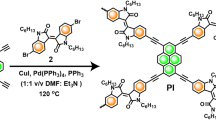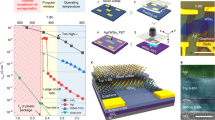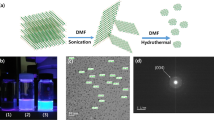Abstract
Nanostructured viruses are attractive for use as templates for ordering quantum dots to make self-assembled building blocks for next-generation electronic devices. So far, only a few types of electronic devices have been fabricated from biomolecules due to the lack of charge transport through biomolecular junctions. Here, we show a novel electronic memory effect by incorporating platinum nanoparticles into tobacco mosaic virus. The memory effect is based on conductance switching, which leads to the occurrence of bistable states with an on/off ratio larger than three orders of magnitude. The mechanism of this process is attributed to charge trapping in the nanoparticles for data storage and a tunnelling process in the high conductance state. Such hybrid bio–inorganic nanostructures show promise for applications in future nanoelectronics.
This is a preview of subscription content, access via your institution
Access options
Subscribe to this journal
Receive 12 print issues and online access
$259.00 per year
only $21.58 per issue
Buy this article
- Purchase on Springer Link
- Instant access to full article PDF
Prices may be subject to local taxes which are calculated during checkout






Similar content being viewed by others
References
Alivisatos, P. The use of nanocrystals in biological detection. Nature Biotechnol. 22, 47–52 (2004).
Zheng, G., Patolsky, F., Cui, Y., Wang, W. U. & Lieber, C. M. Multiplexed electrical detection of cancer markers with nanowire sensor arrays. Nature Biotechnol. 23, 1294–1303 (2005).
Dujardin, E., Peet, C., Stubbs, G., Culver, J. N. & Mann, S. Organization of metallic nanoparticles using tobacco mosaic virus templates. Nano Lett. 3, 413–417 (2003).
Knez, M. et al. Spatially selective nucleation of metal clusters on the tobacco mosaic virus. Adv. Funct. Mater. 14, 116–124 (2004).
Behrens, S., Wu, J., Habicht, W. & Unger, E. Silver nanoparticle and nanowire formation by microtubule templates. Chem. Mater. 16, 3085–3090 (2004).
Richter, J. et al. Nanoscale palladium metallization of DNA. Adv. Mater. 12, 507–510 (2000).
Mao, C. et al. Virus-based toolkit for the directed synthesis of magnetic and semiconducting nanowires. Science 303, 213–217 (2004).
Shenton, W. et al. Inorganic–organic nanotube composites from template mineralization of tobacco mosaic virus. Adv. Mater. 11, 253–256 (1999).
Belcher, A. M. et al. Control of crystal phase switching and orientation by soluble mollusc-shell proteins. Nature 381, 56–58 (1996).
Mirkin, C. A., Letsinger, R. L., Mucic, R. C. & Storhoff, J. J. A DNA-based method for rationally assembling nanoparticles into macroscopic materials. Nature 382, 607–609 (1996).
Mertig, M. et al. DNA as a selective metallization template. Nano Lett. 2, 841–844 (2002).
Karhanek, M. et al. Single DNA molecule detection using nanopipettes and nanoparticles. Nano Lett. 5, 403–407 (2005).
Lee, S. W., Mao, C., Flynn, C. E. & Belcher, A. M. Ordering of quantum dots using genetically engineered viruses. Science 296, 892–895 (2002).
Chung, S. W. et al. Top-down meets bottom-up: dip-pen nanolithography and DNA-directed assembly of nanoscale electrical circuits. Small 1, 64–69 (2005).
Weetall, H. H. Innovations in biomolecular electronics. Biotechnol. Prog. 15, 963 (1999).
Maruccio, G. et al. Nano-scaled biomolecular field-effect transistors: prototypes and evaluations. Electroanalysis 16, 1853–1862 (2004).
Tseng, R. J. et al. Polyaniline nanofiber/gold nanoparticle nonvolatile memory. Nano Lett. 5, 1077–1080 (2005).
Knez, M. et al. Biotemplate synthesis of 3-nm nickel and cobalt nanowires. Nano Lett. 3, 1079–1082 (2003).
Schlick, T. L., Ding, Z., Kovacs, E. W. & Francis, M. B. Dual-surface modification of the tobacco mosaic virus. J. Am. Chem. Soc. 127, 3718–3723 (2005).
Selvakannan, P. R. et al. Synthesis of aqueous Au core–Ag shell nanoparticles using tyrosine as a pH-dependent reducing agent and assembling phase-transferred silver nanoparticles at the air–water interface. Langmuir 20, 7825–7836 (2004).
May, C. J., Canavan, H. E. & Castner, D. G. Quantitative X-ray photoelectron spectroscopy and time-of-flight secondary ion mass spectroscopy characterization of the components in DNA. Anal. Chem. 76, 1114–1122 (2004).
Petrovykh, D. Y., Kimura-Suda, H., Whitman, L. J. & Tarlov, M. J. Quantitative analysis and characterization of DNA immobilized on gold. J. Am. Chem. Soc. 125, 5219–5226 (2003).
Ouyang, J. et al. Programmable polymer thin film and nonvolatile memory device. Nature Mater. 3, 918–922 (2004).
Ma, L. P., Liu, J. & Yang, Y. Organic electrical bistable devices and rewritable memory cells. Appl. Phys. Lett. 80, 2997–2999 (2002).
Gerstner, E. G. & McKenzie, D. R. Nonvolatile memory effects in nitrogen doped tetrahedral amorphous carbon thin films. J. Appl. Phys. 84, 5647–5651 (1998).
Saitoh, M., Takahashi, N., Ishikuro, H. & Hiramoto, T. Large electron addition energy above 250 meV in a silicon quantum dot in a single-electron transistor. Jpn J. Appl. Phys. 40, 2010–2012 (2001).
Chen, S., Murray, R. W. & Feldberg, S. W. Quantized capacitance charging of monolayer-protected Au clusters. J. Phys. Chem. B 102, 9898–9907 (1998).
Ouyang, J. et al. Organic memory device fabricated through solution processing. Proc. IEEE 93, 1287–1296 (2005).
Tseng, R. J. et al. Nanoparticle-induced negative differential resistance and memory effect in polymer bistable light-emitting device. Appl. Phys. Lett. 88, 123506 (2006).
Cai, L. et al. Reversible bistable switching in nanoscale thiol-substituted oligoaniline molecular junctions. Nano Lett. 5, 2365–2372 (2005).
Chemistry WebBook of the National Institute of Standards and Technology, 22nd August, 2006. http://webbook.nist.gov/chemistry.
Hamanaka, Y. et al. Ultrafast electron relaxation via breathing vibration of gold nanoparticles embedded in a dielectric medium. Phys. Rev. B 63, 104302 (2001).
Raja, K. S. et al. Hybrid virus–polymer materials. 1. Synthesis and properties of PEG-decorated cowpea mosaic virus. Biomacromol. 4, 472–476 (2003).
Acknowledgements
This research work was supported by the Microelectronics Advanced Research Corporation (MARCO) Focus Center on Functional Engineered Nano Architectonics (FENA) at the University of California, Los Angeles, and the University of California, Riverside, and the Air Force Office of Scientific Research. We acknowledge assistance from Paichun Chang, Zhiyong Fan and Jia Grace Lu on the CAFM measurements.
Author information
Authors and Affiliations
Contributions
R.J.T. and C.T. designed the experiments. R.J.T. performed memory device fabrication, XPS characterization, CAFM, and electrical measurements. C.T. performed material synthesis, TEM, SEM images and CAFM study. L.P.M. provided feedback and the model for the device mechanism. J.O. provided suggestions on the experiments. C.S.O. and Y.Y. conceptualized and directed the research project. All authors discussed the results and commented on the manuscript.
Corresponding authors
Ethics declarations
Competing interests
The authors declare no competing financial interests.
Supplementary information
Supplementary Information
Supplementary information and figures 1-3 (PDF 64 kb)
Rights and permissions
About this article
Cite this article
Tseng, R., Tsai, C., Ma, L. et al. Digital memory device based on tobacco mosaic virus conjugated with nanoparticles. Nature Nanotech 1, 72–77 (2006). https://doi.org/10.1038/nnano.2006.55
Received:
Accepted:
Published:
Issue Date:
DOI: https://doi.org/10.1038/nnano.2006.55
This article is cited by
-
An ultrasmall organic synapse for neuromorphic computing
Nature Communications (2023)
-
Biomemristor with Phototunable Resistive Switching Characteristics of a Neem (Azadirachta indica)-Carbon Quantum Dots Composite Thin Film
Journal of Electronic Materials (2023)
-
Effects of drying temperature on preparation of pectin polysaccharide thin film for resistive switching memory
Journal of Materials Science: Materials in Electronics (2022)
-
Bio-Nanocarriers for Lung Cancer Management: Befriending the Barriers
Nano-Micro Letters (2021)
-
Proton-enabled activation of peptide materials for biological bimodal memory
Nature Communications (2020)



